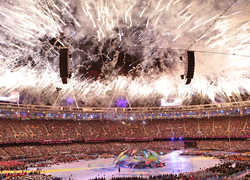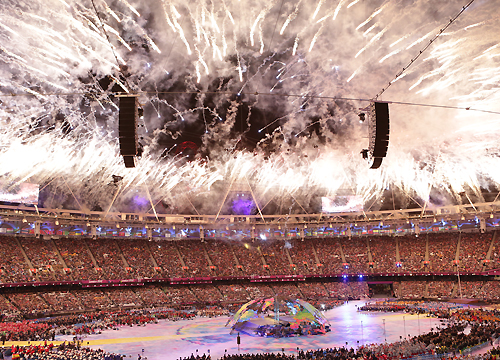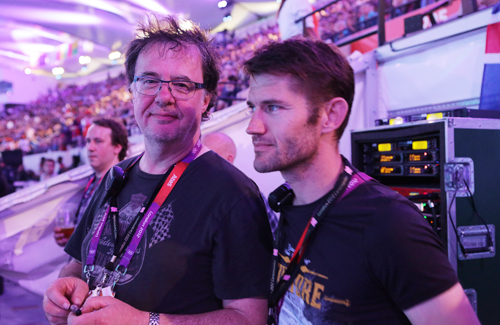
Tuning The System
The tuning phase has to take into account environmental conditions and the acoustics of the loudspeaker system.
The latter have been identified and classified by L-Acoustics for line source arrays in order to create the array morphing tool.
LA8 Filter Set
Having had such experience and success with flexibility of Lake Processing over the years I was skeptical about the limited filtering offered by the LA8 amplifiers. I was even more skeptical about the concept of one set of filters that were the same for all products.
After educating myself about what they have done it makes perfect sense. Some may presume that the limited filtering is a function of DSP resources or not trusting the user to tune the system properly.
This is not the case, the simplicity of the filtering indicates a level of sophistication and understanding of their products that only one or two other manufacturers can compete with.
Array Morphing Tool
The tonal balance of a line source array will vary with the array geometry (array size and array curvature) and also the listening distance. The good news is that these variations are entirely predictable and do not alter the general shape of the frequency response.
L-Acoustics presets were built in such a way that these changes would have a minimum impact on sonic perception, and could be modified easily by using a specific tool in the NETWORK MANAGER called array morphing.
So with only the V-DOSC_LO preset loaded and no FIR or IIR EQ, I experimented with the zoom factor and watched the measurement of a single array change as the value was changed. It made perfect sense.
In terms of the LF Contour, the same process was used and it too made perfect sense. Ultimately the tuning of the V-DOSC used a zoom factor of 0.63 for the Ceremonies and 1.0 for Athletics.
System EQ & Response
On top of the Array Morphing tool L-ACOUSTICS provides a set of IIR filters and FIR filters plateau to deal with environmental factors.
The EQ of the system used all of the IIR filters to tidy up the low-mid response and FIR 2 and FIR 3 to boost the HF response. Considerable time was spent finalizing the EQ between myself, Ceremonies sound designer Bobby Aitken, and Richard Sharratt (front of house mix engineer) for the Olympic Opening.
A wireless four channel measurement system was used to capture four locations in the vertical plane of a single array to confirm the consistency of each array. I was amazed to see and hear how precisely the actual experience matched the modeled performance.
The lower bowl is very difficult to accurately model due to the angle of incidence of the field of play arrays to the seating plane. However, this is very familiar territory for me, so the KUDO performed exactly as I expected and the tuning of the array was delicate but predictable.
The balance between the level of the KUDO arrays and the V-DOSC arrays was tricky. We adjusted the balance countless times to find the best result. It was surprising how noticeable balance adjustments as small as 1 dB made to the experience. We are fortunate that the rehearsal period allowed plenty of time to optimize the system. The extra time spent really does improve the audience experience.
I have to think very hard to remember the occasions where I have experienced component failure in an L-Acoustics system. The reliability of the products was key for London 2012 when you consider how difficult it was to access the flown loudspeakers.
With over 450 loudspeaker products directly exposed to the elements for over four months, our total failures were just two 15-inch woofers. This is a testament, not only to the quality of the L-Acoustics products and systems but also to the efforts Delta Sound made in preparing the systems for the event.
In the end, the system sounded excellent. I had comments from countless people, all praising the sound quality in the stadium. It was a pleasure to be surrounded by such talented people as Bobby and the whole team from Delta, Norwest and Autograph.
Following is a sampling of the comments.
Richard Sharratt, FOH mix, Olympic and Paralympic Opening Ceremonies: “Obviously the scale of the PA system is not something you come across very often, but with Scott and Bobby’s expert nurturing it worked admirably…Working with such a great, friendly and competent crew drawn from many places was a great privilege.”
Gary Bradshaw, FOH mix, Olympic Closing Ceremony: The atmosphere in the stadium was electric. However, amongst the crew the feeling was one of nervous excitement. Having had very little rehearsal on site, the possibility for things to go wrong was looming large in people’s minds. The audience on the other hand were clearly up for joining in the great party atmosphere…it was an honor to be involved in such a great event.”
Piers Shepperd, London 2012 Ceremonies technical director: “All four Ceremonies used a wide variety of audio sources, ranging from the London Symphony Orchestra to Coldplay. The L-ACOUSTICS systems always delivered this audio in incredibly high quality. The stadium audience experienced excellent audio wherever they were seated—no distortion, fantastic intelligibility and accurate reproduction.”
Bobby Aitken, Ceremonies sound designer: “I would like to comment on the 35 sound engineers, designers, managers and crew members that made up our audio team. Never, in my 30-year career have I been honored to work with such a talented and dedicated group of individuals. It was the team, put together by Paul Keating [Delta Sound], Chris Ekers [senior production manager] and Scott that made the audio the success that it was. Of course the choice of equipment is important but, as always, the most critical assets are the people.”
Roland Hemming LOCOG Sporting Venues audio manager: “I think almost everyone commented on the tremendous atmosphere in the stadium and the audio system certainly made a significant contribution to that. The performance of the L-Acoustics systems was excellent.”
I would like to think that the amazing performances from the athletes were due to the brilliant sound system, but perhaps it was also due to their years of training and commitment! The atmosphere was incredible. Take any one element away and it would have suffered.
The presentation of sport is becoming a strong focus for all disciplines and every element of the presentation has to keep up. I’m very proud that London 2012 was the best sounding Olympics ever.


